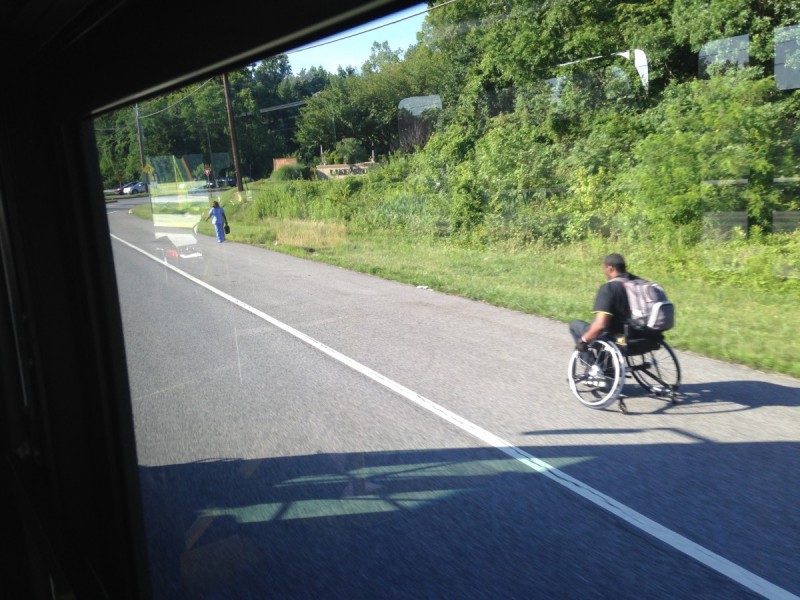Why don’t all state roads in Maryland have sidewalks?

State policy and a maintenance agreement with the local jurisdiction determines whether a state-owned road such as MD 202, shown here, has a sidewalk or not. Image by the author.
Many state roads in Maryland don’t have any sidewalks. At best, that means they’re a hostile or unsafe place to walk. At worst, you may not be able to walk there at all. Why aren’t there more sidewalks? The state is legally obligated to build and maintain roads but not sidewalks, so they’re often patchy at best.
In some instances, it’s reasonable for a state route to not have a sidewalk, like along an expressway. It would be impractical to add sidewalks to very rural routes that don’t have curbs or gutters and have very low levels of traffic. However, many state routes provide direct access to businesses and homes and support substantial economic activity. These routes need sidewalks, but in many cases, do not have them.
What is a state route?
A state route is road, street, or highway that is owned by the State of Maryland. State routes can be easily identified because they have numbers as well as names, and signs that look like this. For instance, MD 201 is Kenilworth Avenue, and MD 355 is Wisconsin Avenue.
If Maryland owns the route, the Maryland State Highway Administration (SHA) is responsible for building, providing access to, and maintaining that route’s right-of-way - which includes not only the roadway, but also the sidewalk (if it exists), the road shoulder, any medians in the road, and any buffer on the side of the road. The state is also responsible for building, maintaining, and updating any of the street lamps, traffic lights, signs, etc. on that road. SHA is also responsible for maintaining US routes, like Route 1, and interstates, like I-95.
A dirt path alongside MD 201 (Kenilworth Avenue) shows where people walk. Image by the author.
State law says Maryland isn’t responsible for sidewalks
Whether or not there’s a sidewalk often depends upon who is responsible for maintaining the road. Let’s look at what Maryland state law says about it.
Maryland Transportation Code, Subtitle 6. Construction and Maintenance, Part 1, Section 8-601 (a) indicates that SHA is responsible for maintaining the roadway:
Powers and duties in general. – The Administration shall construct, reconstruct, and repair State highways as necessary and shall maintain them in good condition.
However, state policy does not require SHA to maintain sidewalks or off-street trails. State policy specifies twice that the state is not responsible for sidewalk maintenance. In the first instance, when the sidewalk is built by a developer, Subtitle 6, Construction and Maintenance, Part 6, Sidewalks, Section 8-629 (c) indicates:
Maintenance of sidewalks. – After sidewalks are constructed under this section, they shall be maintained and repaired by the political subdivision in which they are located.
In the second instance, when the sidewalk is built by SHA, Subtitle 6, Construction and Maintenance, Part 6, Sidewalks, Section 8-630 (c) (6) indicates:
- Except as provided in subparagraph (2) of this paragraph, after sidewalks and bicycle pathways are constructed under this section, they shall be maintained and repaired by the political subdivision in which they are located.
- Subject to approval and availability of funds, the Administration promptly shall reimburse a political subdivision for the preapproved and documented costs incurred in reconstructing a segment of a sidewalk or bicycle pathway that has deteriorated to the extent that repair is not practical or desirable for public safety.
In other words: if SHA builds a sidewalk, or allows a developer to build a sidewalk, then the city or county it’s located in is responsible for maintaining the sidewalk. If the local jurisdiction cannot afford sidewalk maintenance, they may request the state to pay for the maintenance.
As a policy, this makes sense. However, in practice, it works differently. Before SHA will build a sidewalk or allow a developer to build a sidewalk, the local jurisdiction and SHA need to approve a maintenance agreement. If it is not approved, the sidewalk will not be built.
This is a problem for local jurisdictions or developments that are financially constrained and can’t afford to maintain the state’s right-of-way. It results in roads without sidewalks. If the state of Maryland is responsible for maintaining the motor vehicle portion of their routes, they should be responsible for maintaining sidewalks as well.
It’s common to see residents at public meetings blame SHA for missing sidewalks in their neighborhood. However, SHA is a state agency and it doesn’t determine state policy, but it does implement the policies approved by the state’s elected officials. In short, we can’t simply blame SHA that sidewalks don’t exist on some roads.
The best approach to improve this policy is to reach out to your state delegates and senators who make the laws. Let them know that sidewalks are an integral part of public safety, economic development, and transportation equity. The state giving up its responsibility for building and maintaining sidewalks that are along its roadways is a disservice to Maryland’s future.
